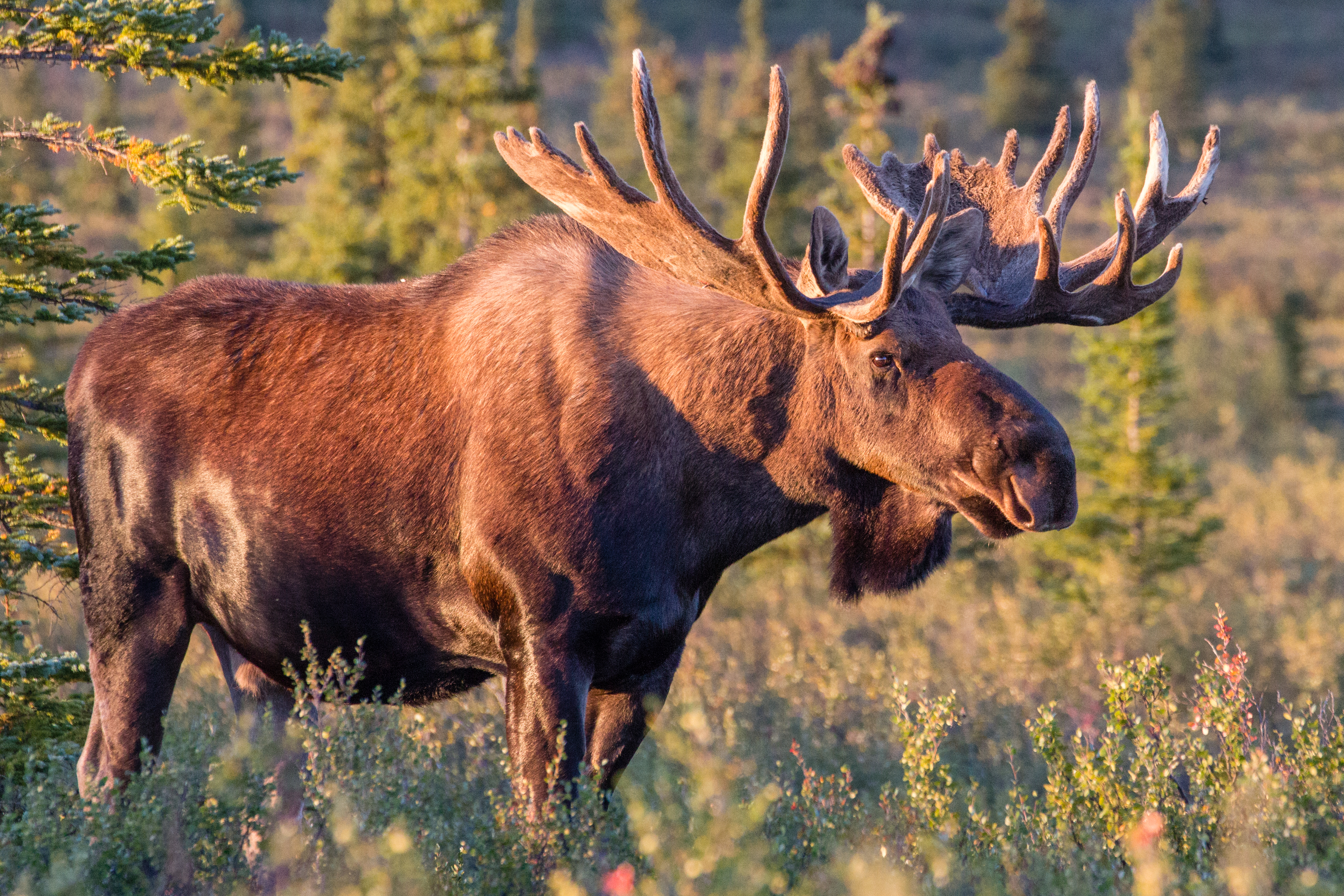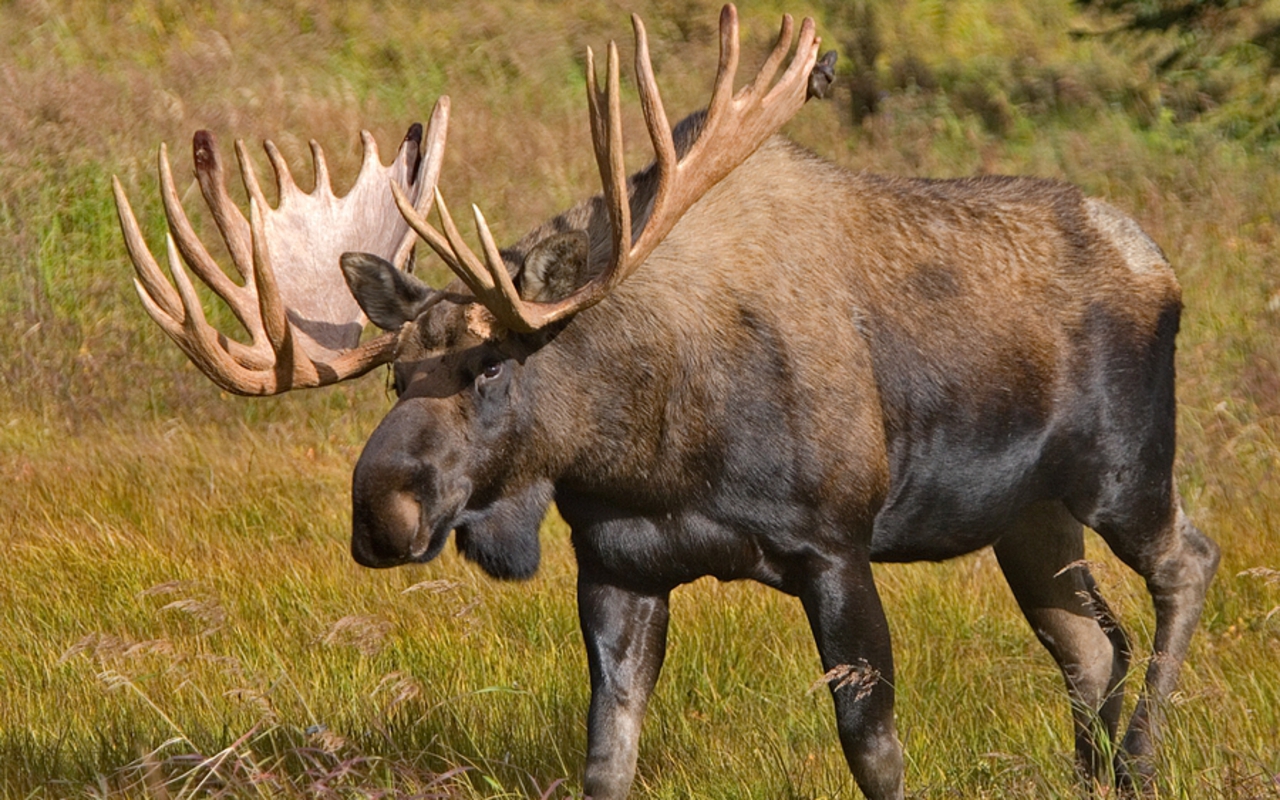
Moose are artiodactyls of the family Cervidae
(deer). Almost all artiodactyls walk on two
toes. Their ancestors had five, but evolution removed
the first toe, and the second and fifth toes
are vestigial. Each support toe-the third and
fourth toes-ends in a hoof. Artiodactyls are herbivores
and many, especially the Cervidae, are ruminants.
This means that they chew and swallow
vegetation, which enters the stomach for partial
digestion, is regurgitated, chewed again, and reenters
the stomach for additional digestion. This
maximizes nutrient uptake from food.
Moose are the largest of deer. Like all cervids,
male moose have solid, bony, branched antlers,
which are shed and regrowneach year. Moose live
in northern Europe, eastern Siberia, Mongolia,
Manchuria, Canada, Alaska, Wyoming, and the
northeastern United States.
Physical Characteristics of Moose
Moose-called elk in Europe-have long, solid
bodies. Males can be eight feet tall at the shoulder,
ten feet long from muzzle tip to rump, and weigh
up to 1,800 pounds. Females are 25 percent
smaller overall. Moose heads, antlered in males,
are angular, long, and have large muzzles. Their
large eyes, as in other deer, are set back on their
faces and on the sides of their heads. This optimizes
their vision. Moose also have thick necks,humped
shoulders, and long, strong legs that allow running
speeds of up to forty miles per hour. Moose
fur is brownish-black, fading to grayish-brown on
the belly.
Moose antlers are large and palmate, holding
up to twenty branched points, which look like fingers
on a hand. Antlers are important during
mating, when a male lacking them would lose
fights for mates and a chance for offspring. Antlers
differ fromtrue horns, which are pointed, permanent,
bony structures often seen on heads of
male ruminants. Horns have bone cores which are
extensions of the skull's frontal bone. Atop the
core is a skin layer, rich in a tough, fibrous protein,
keratin. The high keratin content in this skin
makes it tough and durable. Horns range from
straight spikes to elaborately curved varieties.
Animals having horns keep them for life Antlers
are horns that are shed yearly and regrown.
Like true horns, antlers grow out of skull bones.
They arise from permanent frontal bone structures
called pedicles. At first antlers have soft,
velvetlike skin coverings. Instead of hardening, as
in horns, the covering dies off and is rubbed away
by the animal. Antlers function like horns, serving
for self-protection and allowing males to develop
ascendancy.
Moose are often found on mountains, in forests,
and near lakes and marshes. They are herbivores
lacking upper incisor and canine teeth, but
having pads in their upper jaws to help lower
teeth grind vegetable food. Adults eat up to fifty
pounds of vegetation per day, including water
plants, branches, twigs, and leaves from aspen,
willow and birch trees, berries, and bark.Amoose
often stands up against young trees and bends
them over to reach leaves at their tops. In winter,
moose dig through snow to find grass, twigs, and
other vegetation. Moose eat during the daylight
hours and at night.
The Life Cycle of Moose
Male moose are solitary animals during spring
and summer. In September and October, they
fight for mates. A successful male may lead several
females and babies all winter. In the spring,
the male leaves his harem, returning to a solitary
life. Moose gestation, seven to eight months,
yields one or two offspring which nurse for four
months and stay with the mother until she is
ready to give birth again.Amoose can mate when
it is two years old. The life spans of moose can be
up to twenty years.
Moose are so large and strong that they have
few enemies. Bears and wolvesmayprey on them.
However, they usually attack young, old, or sick
moose and males weakened by hunger or mating
battles. Human hunters are the greatest threat to
moose. For example, during the moose mating
season, male moose seek females. Moose hunters
lure moose into shooting range by imitating the
love call of a cow through a horn or cupped hands.
At one time, hunters killed off almost all moose in
the eastern United States. Currently, they are protected
by law in the United States and Canada.
Moose Facts
Classification:
Kingdom: Animalia
Subkingdom: Bilateria
Phylum: Chordata
Subphylum: Vertebrata
Class: Mammalia
Order: Artiodactyla
Family: Cervidae (deer)
Genus and species: Alces alces
Geographical location: Northern Europe, eastern
Siberia, Mongolia, Manchuria, Canada,
Alaska, Wyoming, and northeastern United
States
Habitat: Mountains, forests, and near lakes or
marshes
Gestational period: Seven to eight months
Life span: Fourteen years, but some live up to
twenty years
Special anatomy: Antlers
Other popular Animals
Photo Gallery of - Moose








 Animalia Life
Animalia Life